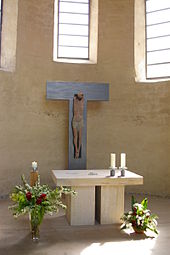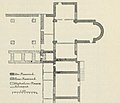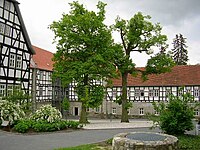Volkenroda Monastery
| Volkenroda Monastery | |
|---|---|
 West side of the monastery church of Volkenroda |
|
| location | Thuringia in Germany |
| Coordinates: | 51 ° 15 '2 " N , 10 ° 34' 4" E |
| Serial number according to Janauschek |
49 |
| founding year | 1131 |
| Year of dissolution / annulment |
1540 |
| Mother monastery | Kamp Monastery |
| Primary Abbey | Morimond Monastery |
|
Daughter monasteries |
1133: Waldsassen Monastery |
The Volkenroda Monastery is a former Cistercian abbey founded in 1131 in the Volkenroda district of the Körner municipality in Thuringia. In 1994 the ecumenical community of Jesus Brotherhood acquired the monastery and made a significant contribution to the restoration of the complex. Since then she has been organizing a communal life there again in the monastic sense and receiving guests for conferences or for a break. In 2005 the Monastery Volkenroda Foundation took over the property. The purpose of the foundation is to promote the Christian faith and an intellectual, social, economic, cultural and social life in the Volkenroda monastery.
history
On the foundation walls of a former palatinate castle, Cistercian monks from Altenkamp founded the first Cistercian abbey in Thuringia in 1131 . In 1150 the monastery church was consecrated by the Archbishop of Mainz. As early as 1130, Countess Helinburg von Gleichen is said to have issued a certificate to the Volkenroda monastery in which a "Ulricus de Schunenburg" is mentioned as a witness.
When it was founded, the monastery was equipped with a considerable amount of land and farms were established. The main income of the monastery was based on privileges and the granting of indulgences. The associated pilgrimages and numerous donations enabled the targeted purchase of land. The monastery also acquired a free courtyard in the imperial city of Mühlhausen, thus getting rid of customs duties at the Mühlhausen borders and using the city gates. Volkenroda soon became one of the richest and most respected monasteries in Thuringia.
Four other foundations came from the monastery - the daughter monasteries of the abbey were Waldsassen Monastery (1133), Reifenstein Monastery (1162), Loccum Monastery (1163) and the Dobrilugk Monastery in Lower Lusatia (1165).
When the Thuringian War of Succession (1247–1264) reached its climax, the abbot at the time ordered the construction of a curtain wall with towers and gates and the defense of the fortifications by hired mercenaries for the security of the monastery.
Towards the end of the 15th century there was a large number of monks and conversations (60/100) in the Volkenroda monastery . But the abbots' abuse of power and bad policies led to the decline of the monastery.
Even before the outbreak of the Peasants' War, the situation around the Volkenroda monastery came to a head. The abbot felt he had an advantage in sending ducal Saxon riflemen in 1517 and had several rebellious peasants "excavated" in the surrounding villages at a favorable opportunity - he wanted to make an example of the peasants as a deterrent and planned a show trial. The outrage over this approach triggered a first storm on the monastery, which the few soldiers were able to repel only with difficulty. The prisoners were released without conviction.
In the course of the peasant war, the Volkenroda monastery was attacked by 100 rebellious Mühlhausen farmers in the morning hours of April 27, 1525 and partially destroyed by arson. According to local tradition, the farmers destroyed the valuable monastery library and numerous religious works of art as well as the collection of relics. In the evening the chests and pantries, stables and cellars were emptied, and the nearby farms of the monastery at Körner and Mehlra were taken. The total damage, as reported by the abbot to the Saxon duke on May 5, was, according to an initial estimate, around 20,000 guilders. A main reason for this outbreak of violence was found in the special position of the monastery before the introduction of the Reformation. Both rural and urban residents harbored grudges against the monastery because it was recently increasingly perceived as an oppressor and not a supporter of the poor. The tax burden of the neighboring towns had increased enormously, the lack of harvests or the handover of taxes in kind prevented by cattle diseases was no longer accepted and the debt was relentlessly demanded. The monastery had also acquired farms in the city of Mühlhausen in order to gain further advantages through trade. The monks even began to influence the established price regulations for natural products in their favor, soon they decided on the fish trade and poured home-brewed beer. Their actions and actions in the city were not prosecuted by secular jurisdiction. Rumors and evidence about the immoral way of life also angered the Mühlhausen clergy, above all Thomas Müntzer and Heinrich Pfeiffer. A direct participation of Müntzer in Volkenroda is now considered unlikely, since neither the abbot nor other representatives of the monastery mention Müntzer in their reports.
After the attack on the monastery, stories and legends soon emerged about murdered monks and the extent of the violence committed. The submitted documents of the actual damage were set off at around 7,500 guilders. For a long time it went unnoticed that the monks had already brought some of their supplies and important documents to the ducal estate in Schwerstedt before the attack. This also included the lists of duties and taxes.
After the suppression of the peasant uprising, some of the monks returned to the monastery, some monks had converted to the Protestant faith and were active as preachers or school teachers, a small number moved to other monasteries that had survived the first onslaught of the Reformation. The Volkenroda monastery was dissolved around 1540 because the sovereign, Duke Moritz von Sachsen, had converted to Protestantism. The greater part of the property was acquired by the imperial city of Mühlhausen and leased to aristocrats and patricians in the form of individual estates. The monastery grounds and the monastery forest remained in the possession of the Saxon princes. In 1641, during the Thirty Years' War, Volkenroda suffered further damage to the residential buildings still standing in the monastery. In the 17th and 18th centuries, the complex deteriorated more and more. In 1802 parts of the church were rebuilt. After the state reorganization in the Weimar Republic, the monastery buildings were used as residential buildings. The monastery church was the village's Protestant church until 1968, before it was closed due to dilapidation. The former ring-shaped monastery wall made of rubble stones and a stone gate from 1574 have been preserved.
Reconstruction to a cultural and educational center
At the beginning of the 1990s there were only a few houses in Volkenroda apart from the monastery ruins. In 1990 the Mühlhausen monument preservationists made the first attempts to save the severely damaged facility. For all buildings that are still partially preserved: monastery church, convent building, circular wall with gate tower, half-timbered courtyard, granary, the recognizable damage images were recorded and assessed in an urgency list. The emergency aid of one million DM made available in 1991 was used as a matter of urgency to save the monastery church, which was the focus of the renovation. The total amount of funds required for the renovation of the monastery was estimated at 20 million DM. Of the church - once a three-aisled basilica, only the choir and transept have been preserved. The wish to gain further knowledge about the building history of the monastery church through excavations and methods of building research had to be rejected at first. In 1993 the Friends of Reconstruction Monastery Volkenroda e. V. founded, the aim of which is to revive the monastic tradition. From 1994 the Jesus Brotherhood took over the buildings from the Gnadenthal Monastery in Hünstelden and revitalized them with a community .
In 1995, the Volkenroda monastery was recognized by the European Union as "European cultural heritage worth protecting". A European youth education center and a guest house were set up in the monastery complex.
Christ Pavilion
In 2001 the Christ Pavilion of the Protestant and Catholic Church was moved from the EXPO 2000 in Hanover to Volkenroda. He took over the function of the no longer existing nave of the monastery church.
Jesus brotherhood and cultural life
The Jesus Brotherhood is an evangelical but ecumenical community. The cohabitation consists of celibate brothers and sisters and families. The members come from different churches and denominations to which they belong permanently. Its center has been Gnadenthal Monastery (Hesse) since 1969 . Since 1994 the Volkenroda Monastery has been an outstation of the community.
- Divine services, Eucharist and prayer times take place daily in Volkenroda . Some services are given special accents: concert services, themed Sundays, Easter Vigil, Valentine's Day and biker service.
- The Volkenroda Monastery is also a regional cultural center with a diverse program of events.
- The Christ Pavilion is the venue for various events such as concerts, workshops, readings and open-air cinema. A big summer concert weekend takes place there every year.
- The Loccum – Volkenroda pilgrimage route has been connecting Volkenroda with the Loccum monastery west of Hanover since 2002.
- With the Via Porta , another pilgrimage route was opened in Volkenroda on May 2, 2010, which connects the monastery with the Cistercian convent Waldsassen .
Monastery property
Agriculture and forestry were among the livelihoods of the monastery. Based on this tradition, the monastery property has been set up as a school farm since 1994. A farmers market is held there on the first Saturday of the month, livening up the village.
literature
- Boetticher, Annette von: [Cistercian monastery] Volkenroda. In: Jürgensmeier, Friedhelm; Schwerdtfeger, Regina Elisabeth (arr.): The monastic and nunnery monasteries of the Cistercians in Hesse and Thuringia. (Germania Benedictina VI / 2). St. Ottilien 2011, pp. 1556–1576.
- JH Möller: History of the Volkenroda Monastery . Rockstuhl Verlag, 2003 (first edition: 1862, reprint).
- Johann Heinrich Möller: The acquisitions and possessions of the monastery Volkenroda . In: Journal for Thuringian history and antiquity . tape VI. . Jena (published in 2011 as a reprint in a shortened edition by Verlag Rockstuhl).
- Katharina Freudenberg: Volkenroda Monastery as a place of Protestant education. Publishing house IKS Garamond, ISBN 978-3-941854-83-3 .
- Ulrike Köhler, Michael Mohrmann, Constantin Beyer: Volkenroda: Monastery - Former Cistercian abbey. 3. Edition. Schnell & Steiner publishing house, 2005, ISBN 3-7954-5931-1 .
- Margot Käßmann, Dieter Ameling: The Christ Pavilion: From Expo 2000 to Volkenroda Monastery. Verlag Stahleisen 2001, ISBN 3-514-00670-9 .
Web links
- www.kloster-volkenroda.de, website of the Jesus brotherhood Kloster Volkenroda
- Volkenroda at www.cistercensi.info
- The west-east monastery
Individual evidence
- ↑ Marc-Stefan Andres: The miracle of Volkenroda. In: Die ZEIT 10/2002. February 28, 2002, accessed August 7, 2018 .
- ^ Herbert von Hintzenstern: Monastery complexes in Thuringia built as if for eternity. Cultural evidence from ancient times. Verlagshaus Thuringia, 1996, ISBN 3-89683-104-6 , p. 53.
- ↑ a b Ulrike Köhler, Jens Reiche, Bertram Lesser, Claudia Wick: Monastery Volkenroda . 3rd, modified edition 2005. Art Guide No. 2180. Schnell & Steiner GmbH Regensburg, 1995, ISBN 3-7954-5931-1 , p. 4; 6 .
- ↑ Steffen Winkler : The coat of arms of the Schönburger . In: "I know an old customer ..." Legends and fabulous stories from Glauchau and the surrounding area . Museum and Art Collection Schloss Hinterglauchau, Glauchau 1981, here p. 9 and p. 31 No. 2.
- ^ Hugo Keil: History of the monastery and office of Volkenroda . In: From the Coburg-Gothaic lands . No. 5 , 1907, pp. 21 .
- ↑ a b Sven Tode: The destruction of the Volkenroda monastery in the Peasants' War in 1525 . In: Mühlhausen museums (ed.): Mühlhäuser contributions . tape 19 . Mühlhausen / Thuringia 1999, p. 79-84 .
- ↑ Ines Gliemann, Martin Sünder: Architectural monuments in the Mühlhausen district . The Volkenroda monastery complex. In: Mühlhausen museums (ed.): Mühlhäuser contributions . tape 15 . Mühlhausen / Thuringia 1992, p. 45-50 .
- ↑ Annett Schödl: Jesus Brotherhood of Volkenroda Monastery . In: Anna-Maria from the Wiesche, Frank Lilie (ed.): Kloster auf Evangelisch. Reports from life together . Vier-Türme-Verlag, Münsterschwarzach 2016, ISBN 978-3-89680-904-9 , pp. 27–32.
- ^ Katharina Freudenberg: Volkenroda Monastery 1990-2001 West German communities in an East German village . 1st edition 2015. Evangelische Verlagsanstalt Leipzig, 2015, ISBN 978-3-374-04147-3 , pp. 105 .










